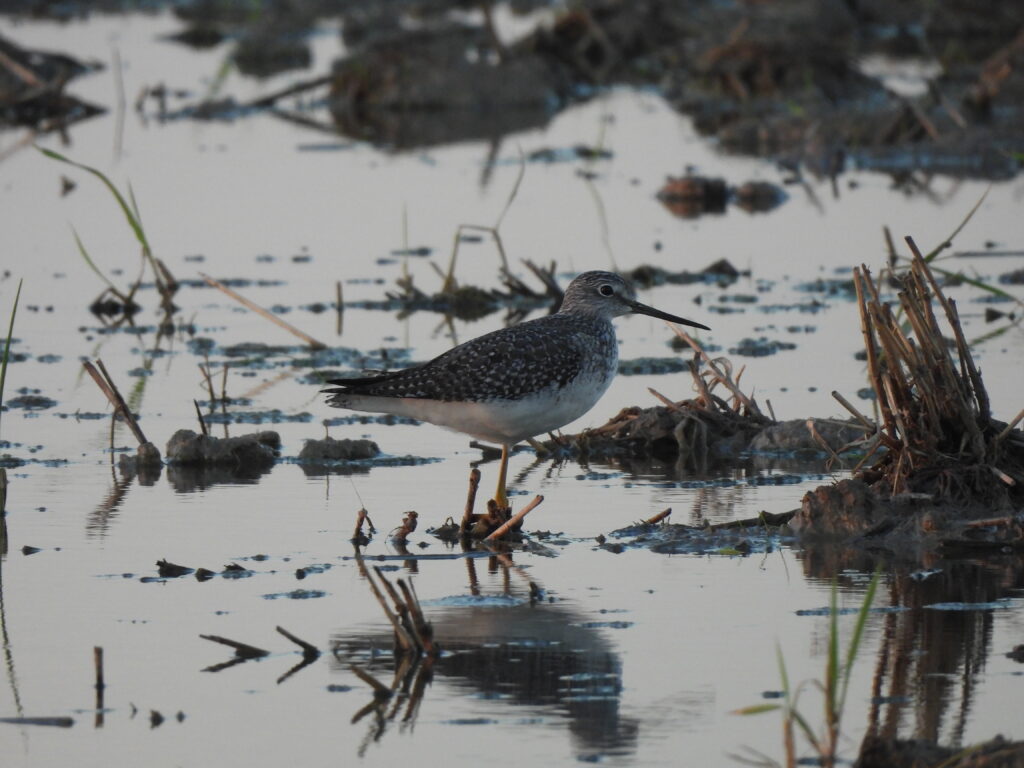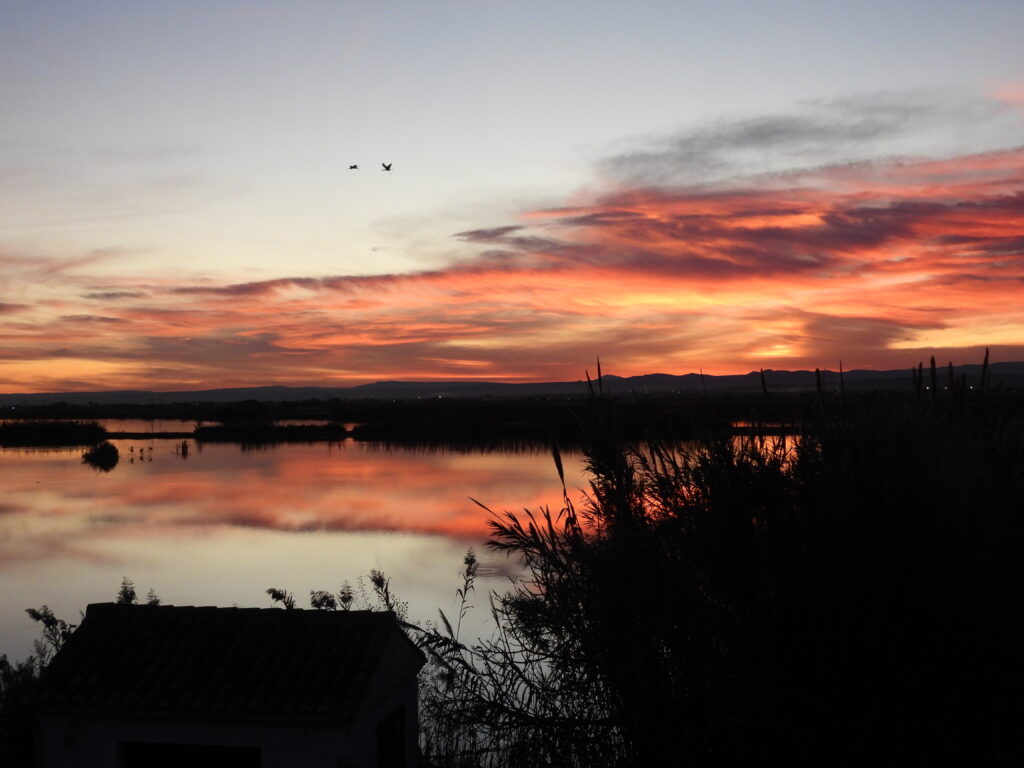L’Albufera Natural Park in Valencia is located just over an hour from my hometown Alcoi, making it a potentially ideal distance for a day trip. This proximity is a blessing, given the remarkable surprises l’Albufera occasionally offers — mega rare birds from distant corners of the globe. A few days ago, Jorge Verdú, Darío Gijón, and I embarked on our first such twitch.

Andrés Balfagón had discovered Spain’s 10th and the Valencian Community’s very first greater yellowlegs (Tringa melanoleuca) on the afternoon of 26th November in some rice paddies south of l’Albufera. Some birders reported the bird’s presence throughout the following day. In the evening, Jorge, Darío, and I rushed to the site, hoping to catch it before nightfall. Joan Balfagón was already there and kindly pointed out the greater yellowlegs under the fading daylight as we arrived. It was the only bird left in an otherwise empty field, as all other waders had departed at sunset.

L’Albufera was full of life, the sunset was incredible and the bird truly obliged — we saw it sit and sleep but it was never reported again. We were excited with our lifer but not entirely satisfied, as the rushed nature of the trip did not feel as proper birdwatching.

This feeling led me and Darío to join Guillem de los Santos today for a full-day birding bonanza at l’Albufera. L’Albufera is his beloved local patch, so joining him here felt great. Despite starting early, traffic delays meant we only reached l’Estany de Pujol after 9. There, a spectacular flock of hundreds of dunlins (Calidris alpina) and dozens of greenshanks (Tringa nebularia) wheeled over the water. Mallards (Anas platyrhynchos), shelducks (Tadorna tadorna), a single gadwall (Mareca strepera), eared grebes (Podiceps nigricollis), and great crested grebes (Podiceps cristatus) swam around. Other highlights included a locally scarce slender-billed gull (Chroicocephalus genei), two pied avocets (Recurvirostra avosetta), and a little stint (Calidris minuta).

The fruits of myrtles (Myrtus communis) were ripe and abundant in the understory of the Aleppo pine (Pinus halepensis) forest of la Devesa, the dune ridge that separates l’Albufera from the sea. These and other bushes teemed with activity, hosting common chiffchaffs (Phylloscopus collybita), Sardinian warblers (Curruca melanocephala), European stonechats (Saxicola rubicola), and black redstarts (Phoenicurus ochruros).

Walking along the beach, the aftermath of the recent DANA (cold drop storm) in late October was starkly visible. Debris stretched along the shore, and the air was filled with the pungent smell of death. The scene of destruction was unsettling, and noticing these are only the remains ashore over a month after the disaster gave the heebie-jeebies.

We continued to the Malladas, the small depressions in the sand within la Devesa. Crested larks (Galerida cristata) and meadow pipits (Anthus pratensis) foraged on the ground, while some Dartford warblers (Curruca undata) flitted between bushes. Overhead, a flock of 11 pintails (Anas acuta) flew toward the sea.

In one section of the Malladas recently scorched by fire and now covered in Cyperus and Carex, we flushed two jack snipes (Lymnocryptes minimus). They set flight silently, only when we were almost at an arm’s length. This was a surprising find for me, as I had never seen such species in this habitat, which seems to serve as a favored wintering ground in the area.

We crossed the dune again to look at the sea. The silhouette of a sanderling (Calidris alba) stood out in the lonely shore. The first bird we saw at the sea was a 1st-winter male common scoter (Melanitta nigra) just 150 m from the coast. The bird was sedimented and gave us great looks for a while. It was my first sighting of the species in the Spanish Mediterranean, where they are scarce and most often observed in very small numbers in flight, usually in active migration, or at very long distances. What a treat.

Our next stop was Racó de l’Olla. After a quick registration, a guard let us in, and we headed toward the main observatory. Hundreds of waterfowl filled the view. Shelducks always steal the show, with males engaging in fierce fights to establish dominance. The size difference between males and females was striking.

Eurasian teal (Anas crecca) formed the largest flock, with over 350 individuals involved in food and love tasks. I recounted to my friends how, five winters ago, I had lifered the American subspecies, the green-winged teal (Anas crecca carolinensis), among a such large flock at this very spot. Although no carolinensis turned up this time, Darío spotted a garganey (Spatula querquedula), an unexpected find as this species is rarely seen in Spain outside migration periods.

From the tower at the visitors’ center, scopes revealed more waterfowl around la Mata del Fang, a reed-covered island on the main lake of l’Albufera, visible in the distance. We enjoyed good wintering numbers of mallards, red-crested pochards (Netta rufina), pintails, shovelers (Spatula clypeata), gadwalls, and common pochards (Aythya ferina).

Driving south, the fields were particularly flooded with some areas. The whole landscape was alive with astounding numbers of gray herons (Ardea cinerea), great egrets (Ardea alba), black-headed gulls (Chroicocephalus ridibundus), and lesser black-backed gulls (Larus fuscus). The road also provided other cherished sights, such as a Squacco heron (Ardeola ralloides) very late in the season — the species is usually a summer visitor.

At Tancat de l’Illa, we encountered Eurasian coots (Fulica atra), white wagtails (Motacilla alba), several swamphens (Porphyrio porphyrio), and gray wagtails (Motacilla cinerea). A common snipe (Gallinago gallinago) posed photogenically for a change, while common kingfishers (Alcedo atthis) zipped across the water like blue beams.

Later, the fields near Muntanyeta dels Sants offered different treasures. In shallow waters in the distance, flamingos (Phoenicopterus roseus) waded elegantly. In fields with lower water level, glossy ibises (Plegadis falcinellus) and cattle egrets (Bubulcus ibis) foraged nearby. Hundreds of northern lapwings (Vanellus vanellus) mixed with European golden plovers (Pluvialis apricaria) and ruffs (Calidris pugnax) are always a pleasure to see, and we managed to spot several of such flocks. So did several kestrels (Falco tinnunculus) and western marsh harriers (Circus aeruginosus) and a peregrine falcon (Falco peregrinus) patroling nearby — Guillem even spotted a merlin (Falco columbarius).

Intense days in the field in winter always concur with the same idea: the sun never sets late enough. By 17, we had headed to our final destination of the day: Tancat de Mília. From a privileged viewpoint at an observation tower facing the main lake, we enjoyed the view and the birds on the move towards their roosting areas. A booted eagle (Hieraaetus pennatus), perched in its own privileged viewpoint, also glimpsed the scene.

Flocks of thousands of glossy ibises are one of the highlights of l’Albufera evenings. One of such flocks with only few birds flew right above our heads, and an odd, very large, white ibis stood out — the African sacred ibis (Threskiornis aethiopicus) that had escaped some years ago and since joined glossy ibises at l’Albufera.

The views were awesome as it got dark, and we had a harder time to spot the chiffchaffs, little bitterns (Botaurus minutus), swamphens (Porphyrio porphyrio), and water rails (Rallus aquaticus) that called around us. We soon found ourselves in an open area in l’Albufera, after a successful and satisfying birdwatching session, under a paradisiac sunset.

Both birdwatching times at l’Albufera finished with great people and memorable sunsets. However, the level of fulfillment today has been very positive. L’Albufera is a gem of a wetland, and seeing it through the eyes of friends who have it as their local patch and know its potential is a treasure.




